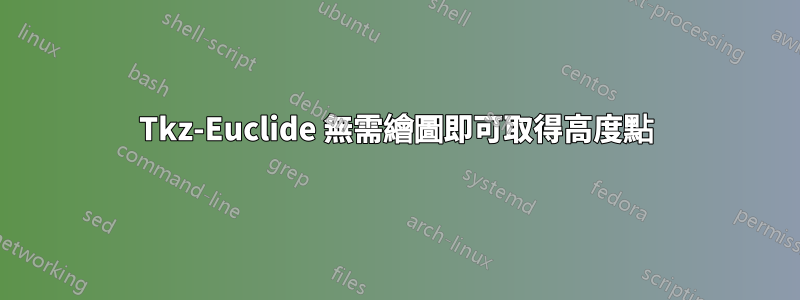
是否可以只取得座標而不進行繪圖? (或者有其他不使用的快捷方式嗎tkz-euclide?
\documentclass[tikz,border=10pt]{standalone}
\usepackage{tkz-euclide}
\usetkzobj{all}
\begin{document}
\begin{tikzpicture}
\coordinate (A) at (0,0);
\coordinate (B) at (4,4);
\coordinate (C) at (4,2);
\draw(A)--(B);
\tkzDrawAltitude[color=blue](A,B)(C) \tkzGetPoint{D}
\fill[red] (A) circle (2pt);
\fill[red] (B) circle (2pt);
\fill[red] (C) circle (2pt);
\fill[blue] (D) circle (2pt);
\end{tikzpicture}
\end{document}
答案1
是的,calc有這些預測。它們的語法在章節中描述13.5.5 投影修改器的語法pgf 手冊的。
\documentclass[tikz,border=10pt]{standalone}
\usetikzlibrary{calc}
\begin{document}
\begin{tikzpicture}
\coordinate (A) at (0,0);
\coordinate (B) at (4,4);
\coordinate (C) at (4,2);
\draw(A)--(B);
\draw[blue] ($(A)!(C)!(B)$) coordinate (D) -- (C);
\fill[red] (A) circle (2pt);
\fill[red] (B) circle (2pt);
\fill[red] (C) circle (2pt);
\fill[blue] (D) circle (2pt);
\end{tikzpicture}
\end{document}
答案2
對於 tkz-euclide,正確的程式碼是:
\documentclass[tikz,border=10pt]{standalone}
\usepackage{tkz-euclide}
\usetkzobj{all}
\begin{document}
\begin{tikzpicture}
\tkzDefPoint(0,0){A}
\tkzDefPoint(4,4){B}
\tkzDefPoint(4,2){C}
\tkzDrawSegment(A,B)
\tkzDefPointsBy[projection=onto A--B](C){D}.
\tkzDrawPoints[color=red](A,B,C)
\tkzDrawPoints[color=blue](D)
\tkzLabelPoints(A,B,C,D)
\end{tikzpicture}
\end{document}
答案3
替代方案土撥鼠的很好的答案。\pgfmathanglebetweenpoints命令給出直線的角度。使用這個命令和intersections庫,無需繪圖即可獲得座標。
\documentclass[tikz,border=10pt]{standalone}
\usepackage{tkz-euclide}
\usetkzobj{all}
\usetikzlibrary{calc,intersections}
\newcommand{\pgfextractangle}[3]{%
\pgfmathanglebetweenpoints{\pgfpointanchor{#2}{center}}
{\pgfpointanchor{#3}{center}}
\global\let#1\pgfmathresult
}
\begin{document}
\begin{tikzpicture}
\coordinate (A) at (0,0);
\coordinate (B) at (4,4);
\coordinate (C) at (4,2);
\path[draw, name path=line1](A)--(B);
\pgfextractangle{\angle}{A}{B}
\fill[red] (A) circle (2pt);
\fill[red] (B) circle (2pt);
\fill[red] (C) circle (2pt);
\path [name path=line2] (C)--++(\angle+90:3); % Add 90 degree to calculated angle for orthogonality.
\path[name intersections={of=line1 and line2,by={D}}];
\fill[blue] (D) circle (2pt);
\end{tikzpicture}
\end{document}






